Ireland is known as “The Emerald Isle” because of its lush green landscapes but it’s famous for its hospitality. Whether you’re at a golf club, in your B&B, at a pub or touring a castle, you’ll certainly be treated warmly by the wonderful Irish people. Our guests always return happy so pick Ireland for the wonderful golf and the most memorable travel experience you can imagine!
Ballybunion (Old)
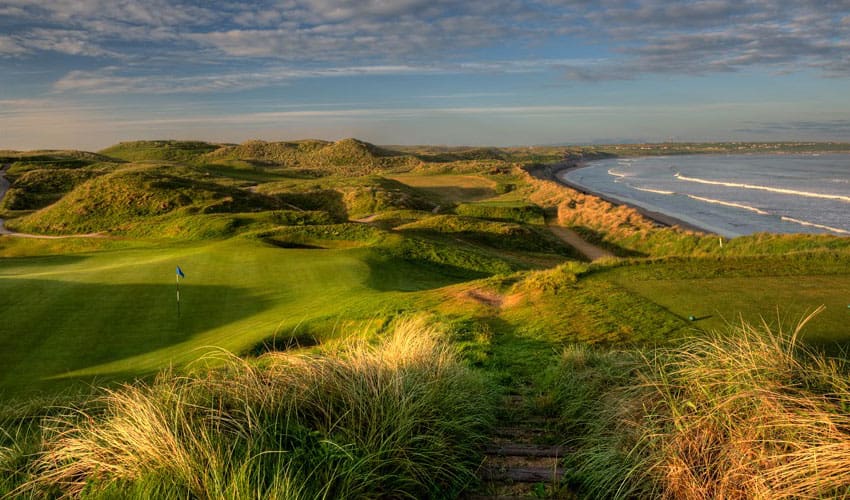
The Old Course at Ballybunion is a masterpiece. Each hole here is special and unique. The immediate thing you notice right along the first fairway is a graveyard filled with chest high tombstones. Not the type of place you want to hunt for your errant drive. There are massive dunes here and the routing moves swiftly through them with a certain grace as though the holes were dropped in unobtrusively. Oddly, there are many fairways with level lies, more so than other links that play through similarly tall dunes.
We love the par 3s at Ballybunion. Holes 3, 8, 12, and 15 are the par 3s - these are wonderful par 3s. The 3rd hole plays at 213 yards from the medal tees from a flat elevated tee to a lower green protected by 3 pot bunkers with a large grass bunker short right. The 8th hole is just a beautifully sited par 3 that plays just 137 yards with the green sitting in a bowl surrounded by dunes and guarded by 3 dangerous bunkers. Hole 12 is an amazing par 3 where you hit from an elevated tee to an elevated green, 175 yards across not one but 2 valleys. The green’s defenses are a deep pot bunker back left, several grass bunkers and a steep runoff left of the green. Our favorite par 3 is the fifteenth that plays a very long 204 yards to a two-tiered green with four marvelous bunkers with the sea as your backdrop. This hole plays into the prevailing wind so be sure to bring plenty of clubs. These are four of the best one-shooters in golf!
If time allows, we highly recommend the second course at Ballybunion, the Cashen Course. Designed in the 1980s by Robert Trent Jones, it plays over and through the same rugged links land as the Old and is a stern test in its own right. After your round, relax in the comfortable clubhouse and enjoy the spectacular views out over the course and out to sea.
Carne GC
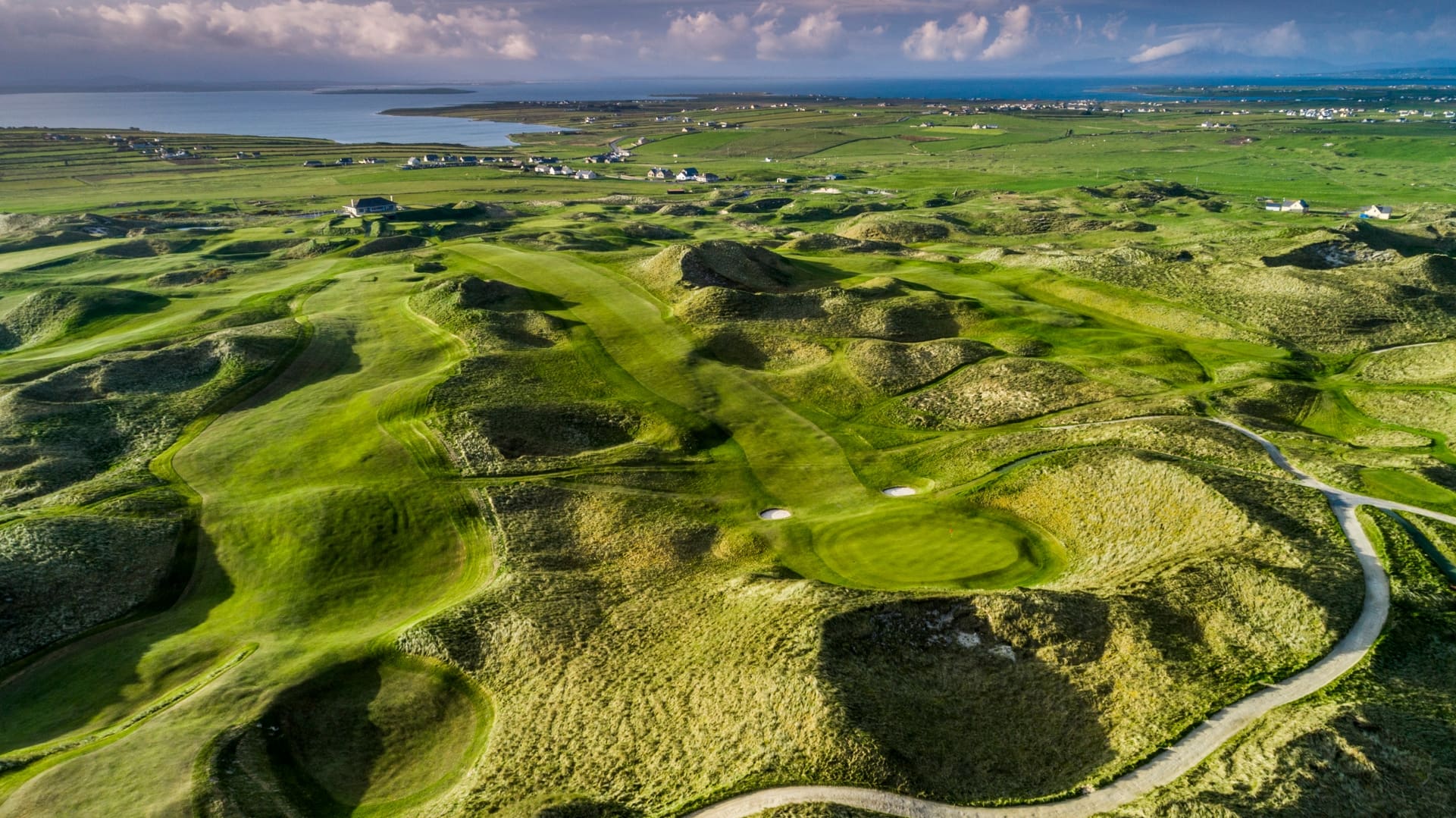
The Carne Links at Belmullet is the late Eddie Hackett’s swan song and many reckon it’s his finest design. The course sits in splendid isolation on the Atlantic edge of County Mayo. It lies on a peninsula, amidst gigantic dunes with far reaching views across Blacksod Bay to the Atlantic islands of Inis Gloire and Inis Geidhewild. Everything is absolutely breathtaking.
It’s difficult to believe that the course only opened for play in 1993. It feels as though it’s been here forever. Many of the greens and tees are sited naturally and, for such a modern course, very little earth-moving was required during the construction.
Carne was originally developed to attract tourism to the city of Carne. The beautiful area is filled with towering sand dunes and a magical lunar landscape. This 6,700 yard links is not a simple out and back affair. Each nine goes to and from the clubhouse and the fairways snake through the dunes. As with any coastal course the wind is a huge factor; on an average day you may shoot your handicap but if the weather is wild you may want to hold on for dear life. A trip to Ireland’s beautiful west coast would not be complete without playing Carne. Include County Sligo, Enniscrone, and Connemara on your itinerary, alongside Carne, and you’ve played four of the most natural beautiful links courses in the world. And do not forget to visit the 9-hole course in Carne called Kilmore. It is said to be one of the best 9-hole courses in the British Isles. Carne comes in at 12th for England and the top course in Mayo.
Connemara GC
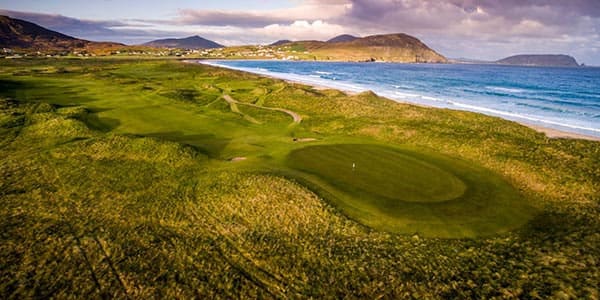
Connemara is located on the rugged, tranquil and unspoilt Atlantic coastline at Ballyconneely, situated on a peninsula, jutting into the Atlantic between Clifden to the north and Roundstone to the south.
Founded in 1973, and designed by the prolific Irish architect, Eddie Hackett. Connemara is one of the toughest links courses in the world, measuring more than 7,200 yards from the back tees. The course is covered with stern and craggy rocks. Avoid these rocks at all cost to stray away from some interesting shots. Connemara has 27 holes; the A nine and the B nine consist of the championship course and the C nine is shorter in length.
The wind is a significant factor here because there are no sand dunes to protect you from it. The land is mostly flat on the course which creates the most magical panoramic views of the ocean with glorious white sandy beaches to the northeast as well. The Austere Twelve Bens mountain range provides a dramatic backdrop as well.
Connemara is a very remote golf course but everyone is exceptionally welcoming. The last six holes will remain etched in the mind for a very long time. If you are brave enough to attack this course from the back tees then good luck. This course is #22 in Ireland and it is ready for you!
County Louth GC (Baltray)
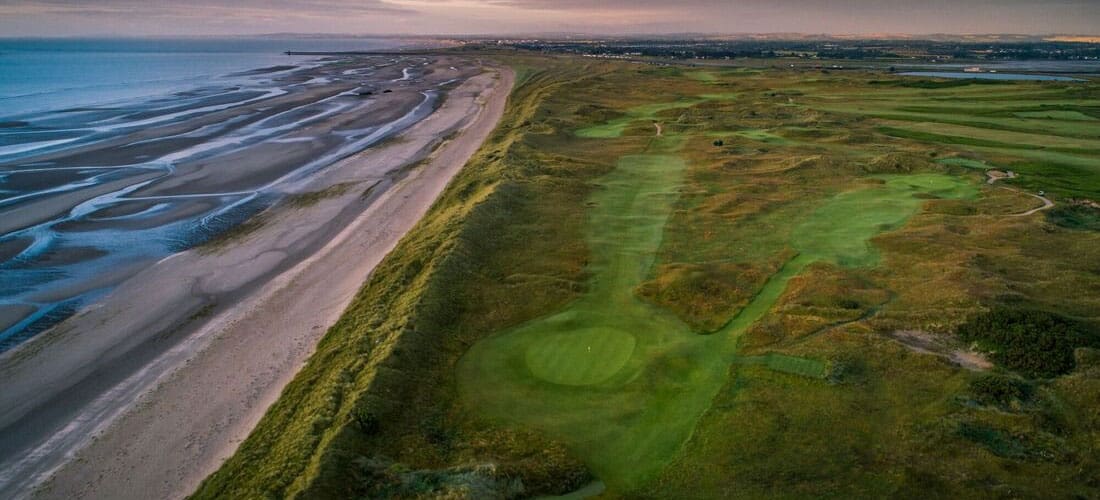
County Louth Golf Course is actually better known as Baltray after the small fishing village where it lies. Baltray is one of Ireland’s best kept secrets when it comes to golf despite having hosted the Irish Open in 2004. The club was established in 1892 and laid out by Tom Simpson and the course has been updated several times, most recently in 2003 when it was lengthened to 7,000 yards.
Baltray features two loops of nine holes vs. an out and back, traditional routing and the holes run in multiple directions which makes judging the wind especially difficult. The wind is Baltray’s primary defense although the wonderful bunkers must not be overlooked. There are eighteen strong holes here and the greens are revered as the best in Ireland - to not three-putt here is quite an achievement!
Here you’ll find that the sixth hole starts a wonderful stretch of golf holes. The sixth is a 521 yard par 5 that plays as a slight dogleg left with a dangerous fairway bunker down the left to protect against those attempting to take a shortcut. The green is raised and looks like an upside down soup bowl with deep grass bunkers on both sides. Next is the par 3 seventh which plays to 153 yards to a green that is beautifully sited with 2 deep bunkers fronting the green. The eighth is a long par 4 with 2 wonderful fairway bunkers down the right side playing to a green fronted by bunkers left and right. The ninth is another superb par 4 that plays back to the clubhouse with six fairway bunkers - four down the left and 2 along the right. The green is protected in the front by a large bunker twenty yards short of the green and two additional bunkers past the middle of the green both left and right.
Baltray is an exceptional links that will surely bring out your best!
County Sligo GC
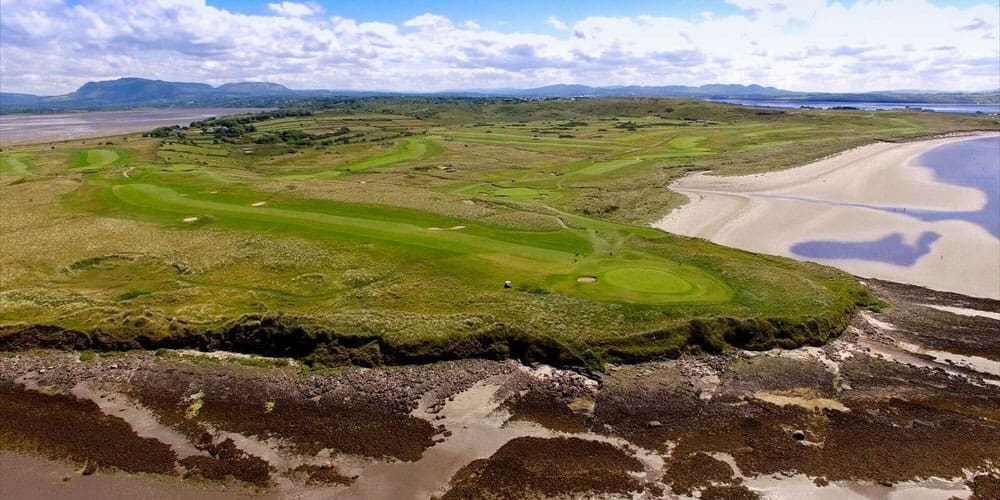
County Sligo, more known as Rosses Point, is an exhilarating west coast links, situated in the heart of Yeats country. Sligo started out as a 9-hole course, designed by George Combe (Contriver in 1896 of the world’s first handicap system), and opened for play in 1894 . At the turn of the 20th century, Willie Campbell extended the course to 18 holes. The famous Colt and Alison partnership remodelled the course in 1927.
There are many beautiful courses in the British Isles and this one fits right into the mix. The views of the Darty Mountains and Benbulben, Sligo’s limestone “Table Mountain'', are simply stunning. Drumcliffe Bay sweeps around the golf course. It's fine long sand beaches, the Atlantic and the harbour are often in full panoramic view. The Ox Mountains - Knockalong the highest peak - add further dimension to the already stunning vista. In the same vein as the scenery, County Sligo is a real joy. It has strategic links with dramatic undulations, raised plateau greens, run-offs, high ground, low ground, cliffs, challenging bunkering, and burns and dunes. County Sligo has it all, including unusual routing over three distinctly different sections. The back nine, especially the 11th to the 17th, played on the headland, are truly magnificent. The sheer individuality of holes and the carried terrain makes County Sligo an absolute must-play golf course.
County Sligo is home of the West of Ireland Amateur Championship and host to other important amateur events. County Sligo is an astounding 7th in all of Ireland and you can not miss out on a chance to play here.
Cruit Island GC
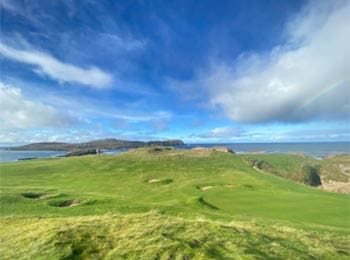
Cruit Island Golf Club is one of the world’s best 9-hole layouts and perhaps the most scenic, as well. Set on the edge of the wild and rugged Atlantic with the sea never out of view, Cruit overlooks Owey and Arranmore Islands with Mt. Errigal off in the distance. Cruit Island is a beautiful and wonderful test of golf. Located in a remote part of Donegal, Cruit is what we call a “diamond in the rough” and one worth the effort to find.
The 9-hole layout plays at 2,809 yard and starts strong with two par-4s that measure over 400-yards. Cruit features 7 par-4s and 2 par-3s with the par-3 eighth playing at a very demanding 213-yards. With so many great holes, it’s the par-3 sixth hole that stands out as their signature hole. This sixth hole plays over a cavernous gorge and with the sea on the right to a green 150-yards away. It’s a beautiful yet daunting tee shot that’s made more so by the ever present wind that plays predominantly into you.
The club was founded in 1986 and laid out by Derry professional, Michael Doherty. The club is especially proud of the fact they were one of the first clubs in Ireland to admit lady members and the very first club to have a woman to serve as president.
Do not miss the opportunity to play Cruit Island and experience the very warm Irish welcome that has made the club so famous.
Dingle GC
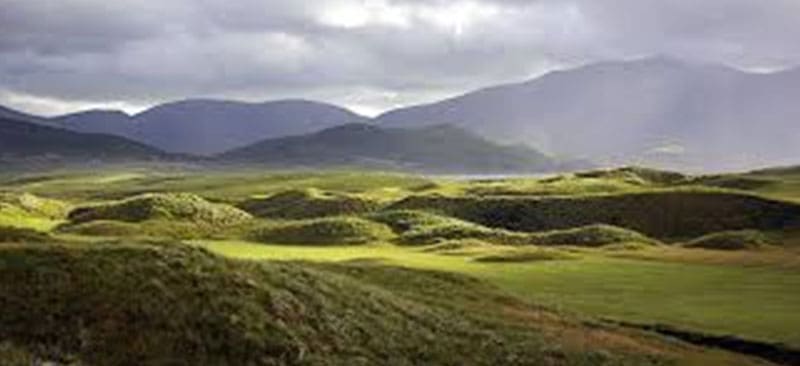
Dingle Golf Club or as it is known in Gaelic, Ceann Sibeal, is the western-most course in Ireland (and for that matter, Europe) making it the closest golf course to the shores of N. America. There is nothing fancy about this traditional and unpretentious links course, which was designed by the great Eddie Hackett. The course overlooks Dingle Bay and it can get unapologetically windy here. At 6,700 yards, it’s a testing but fun course and I know no one who would leave here without thoroughly enjoying the experience - it’s truly a diamond in the rough.
The original Dingle Golf Club was formed in 1924 at Doonsheane, three miles east of the town, near the racecourse with club’s main meeting spot in Ashe's Pub in Dingle. It disbanded in the 1960s, as local farmers required the land back but the club stayed in existence and reformed in the 1970s at the links in Ceann Sibeal where it is today. The club now plays on a rugged and remote links course that has been updated over the years. It was originally a 9-hole course designed by Eddie Hackett and was later extended to 18 holes with input from Christy O'Connor junior. Little was done in the way of earth moving when the holes were laid out. Dingle has a simple, straightforward routing as holes are etched into the natural landscape with a meandering burn dissecting the property to add interest and a little danger in equal measure. Throw in some strategic bunkering and gently undulating terrain and it amounts to a real test of links golf. The views out to the Blasket Islands in the Atlantic are simply spectacular and well worth the effort to seek out such a secluded golfing spot in an area rich in Gaelic tradition where the Irish language is still very much a part of everyday life. This is a wonderful club with a lovely course and very friendly members!
Donegal GC
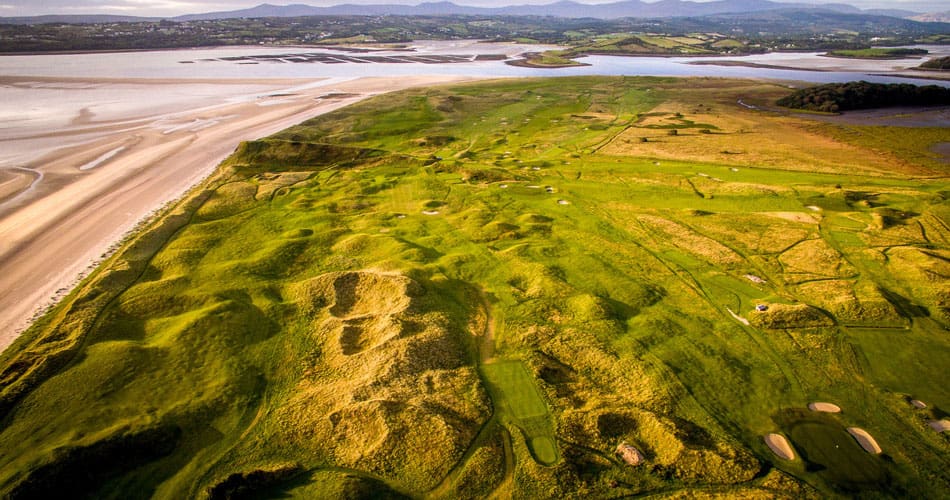
The Murvagh peninsula jutting out into Donegal Bay is the home of Donegal Golf Club. It’s an enchanting and isolated setting for a big links course. The panoramic view across the bay is sensational, with the Bluestack Mountains providing a dramatic backdrop.
The prolific architect, Eddie Hackett, laid out the course in 1973, and Murvagh is considered to be one of his finest creations. Hackett was given a naturally rugged and crumpled piece of links land to work with and he used all of that land to create a massive championship course that measures to 7,200 yards from the back tees. Unless you’re a pro or a very low handicap golfer you should probably stay away from the back tees.
Donegal’s layout is laid out with two elongated loops of nine holes. The front nine runs anticlockwise and the back nine runs clockwise. The first four holes are fairly ordinary, feeling more of an inland course at the start; and then at the 185-yard par three 5th, we enter dune country. This hole is called “Valley of Tears”, and it is a brute. A semi-blind tee shot to a narrow plateau green protected by a lowered sand bunker in front of the raised green. The next three holes are stunning where the fairways roller coaster up and down, flanked to the left and right with massive sand dunes. At the turn, we have a thrilling back nine that includes a monster par 5 and the sadistic par three 16th, measuring, from the tips, 250 yards.
There is no doubt that this course is very challenging, and any profound golfer would have to play it. At #18 in Ireland this course is one to dream about conquering.
Dooks GC
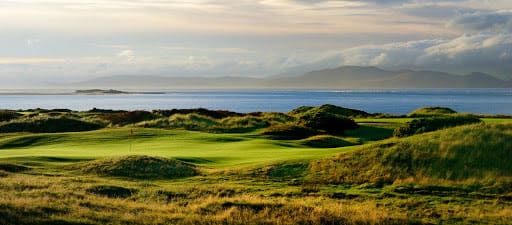
Environmentally, Dooks Golf Club has to be one of the most natural golf courses in the world. Everything is in harmony with its surroundings - it's a beautiful place for golf. The course is enchantingly located on a promontory on the southern side of Dingle Bay. The MacGillycuddy’s Reeks mountains stand guard to the southeast and stretched out in the foreground to the north and the west are the sandy peninsulas or Rossbehy and Inch Point. The vista is simply breathtaking.
Officers from the Royal Horse Artillery laid out a short nine-hole course in 1889 and they introduced the local gentry to the game of golf. This establishes Dooks as Kerry’s oldest golf course. Around 1900, the course was extended to 18 holes, but due to escalating costs, the club soon reverted back to nine holes.
In 1963, Dooks received a letter from the land agent getting back possession of the leased land that the golf course was on. Immediately, a “Save Dooks” campaign was launched and for the next two years the golf club was front page news. £7000 was eventually raised and in 1965, the members became the proud owners of Dooks Golf Club. Dooks then grew in publicity and the course now needed 9 more holes. In 1970, against all odds, a new extended 18-holes Dooks opened for play designed and built by the members. The outcome was wonderful, the new holes blend perfectly with the old.
Dooks is an engaging and fun golf course with a true and traditional links experience. THe course is not championship length but a mere 6,500 yards. Don't let that fool you, it is a thoroughly enjoyable challenge. Dooks is ranked #26 in Ireland and a great addition to any golf trip.
Lahinch GC
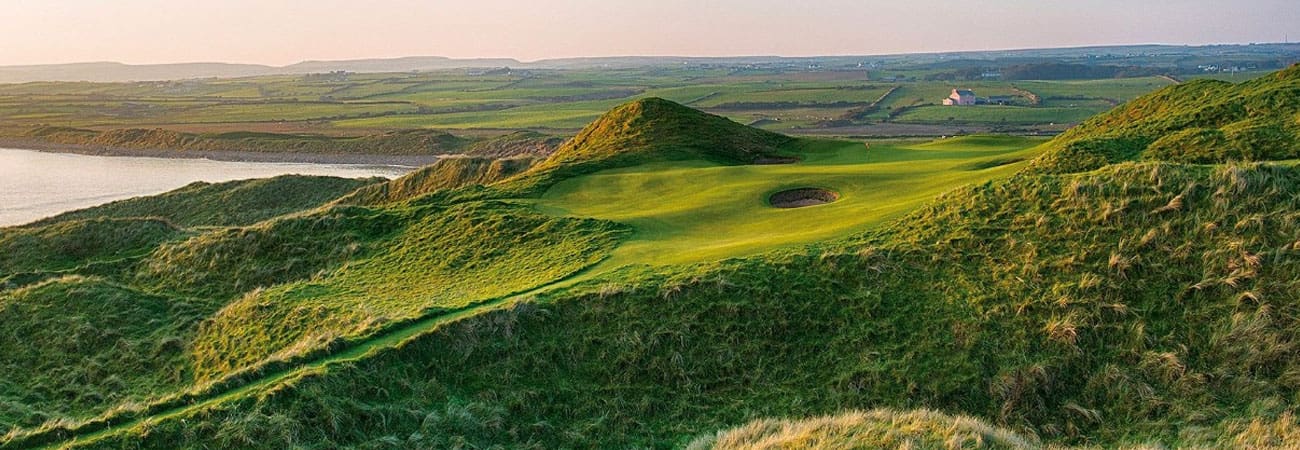
Lahinch is one of the courses that should be on everyone’s bucket list. The club was founded in 1892 and laid out by some military officers of the Scottish Black Watch. Later it was redesigned by Old Tom Morris in 1894 and then by Augusta National architect Dr. Alistar MacKenzie in 1927. In the 1930s, the greens committee decided that the greens were too difficult for the average golfer so John Burke was hired to “flatten them out”. Fortunately, the club hired Martin Hawtree in 1999 to restore the course and take it back to the characteristics that MacKenzie had featured in his layout.
The links at Lahinch are famous for their par-3 fifth hole known as Dell. This requires a blind tee shot to a green obscured by towering dunes on all sides and a narrow gap with a path to enter this natural amphitheater. It’s a wonderful quirky hole and one of OldTom’s remaining, untouched holes. A white stone is placed atop the front dune as an aiming mark. Aim over the stone for the hidden flag, pray your ball clears the dune, and enjoy the ride.
Our favorite hole is the long and visually intimidating par-4 seventeenth that plays at 408-yards from the member’s tees at stroke index 4. From an elevated plateau, you tee off to a generous fairway that narrows as you approach the green complex. Hitting the fairway and green in the heavy wind is a true challenge not made any easier by two pot bunkers that front the hole - it all makes for a very dramatic penultimate hole.
We first played here a long time ago and I asked the pro what the weather forecast was for the day. He replied, “Check the goats”. As it turns out,the club has a broken barometer so for more that 100 years they have relied on local goats to forecast the weather. If the goats are out on the course and out of sight, it will be a fine day but if the goats are huddled near the clubhouse, you can expect rain. Trust the goats and enjoy your day on these amazing links!
Old Head GC
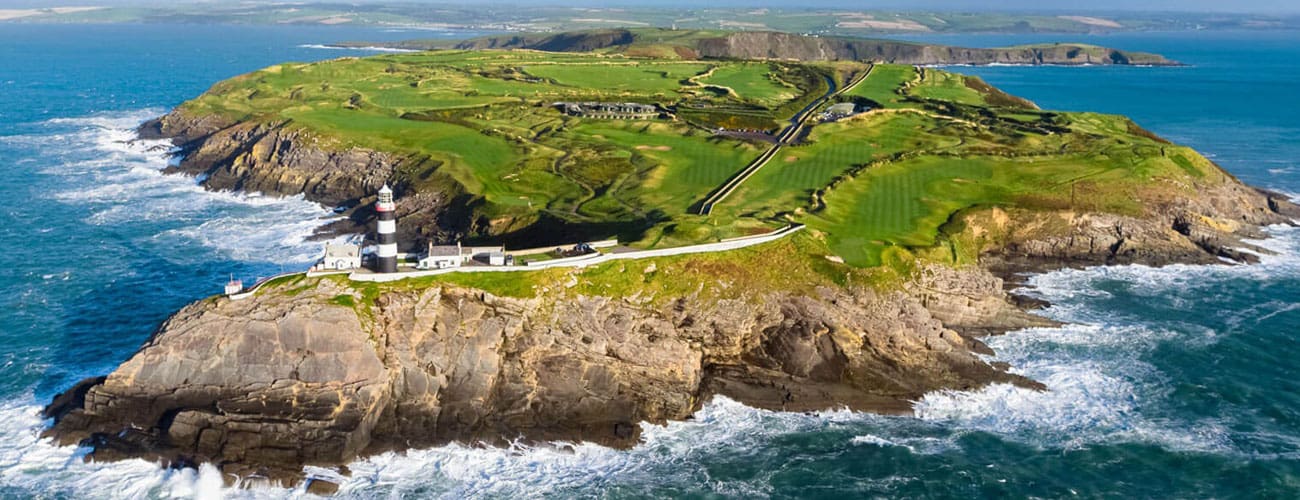
This is clearly the most beautiful links golf site in the world! Old Head is a diamond shaped, 2-mile long stretch of land that juts out into the Atlantic Ocean and sits 300 hundred feet above the waves below. The same waves that saw the civilian carrying RMS Lusitania sink below the Atlantic waters in 1915 after being struck by torpedoes from a German U-Boat. Built in 1997 and located on 220 acres of pure heaven, Old Head is one of the most memorable days one can have on a golf course.
In N. America, Pebble Beach is widely regarded as our most beautiful golf course but Old Head is on a whole other level. It’s an exhilarating course to be sure and it also has some undoubtedly excellent golf holes. We love the audacious and difficult par-5 twelfth hole that plays along a very narrow stretch of land on the edge of a cliff with the rocky shore below. It has to be the most intimidating hole in golf as it stretches out to 530-yards with the fairway narrowing as you approach the green. There is a reason this is stroke index 1 at Old Head.
The final two holes are very memorable, as well. Seventeen is a long par-5 at 575-yards and hitting the fairway on your drive, and second shots, are a must if par is to be had. It’s a beautiful hole with the lighthouse at the point in view the whole way. Eighteen is a wonderful closing hole with 400-yards to traverse along a dogleg left with out-of-bounds right. Hitting the fairway here is a must for par here. Your approach must carry the green or be repelled off the green’s false front. Stay clear of the bunker left of the green on your approach as it’s quite deep and not an easy out.
A round at Old Head will be one of the most remarkable rounds you will ever play. Make time for a pint in their bar with a spectacular view out over the Atlantic where you can ponder your play that day and what lies ahead tomorrow.
Portsalon GC
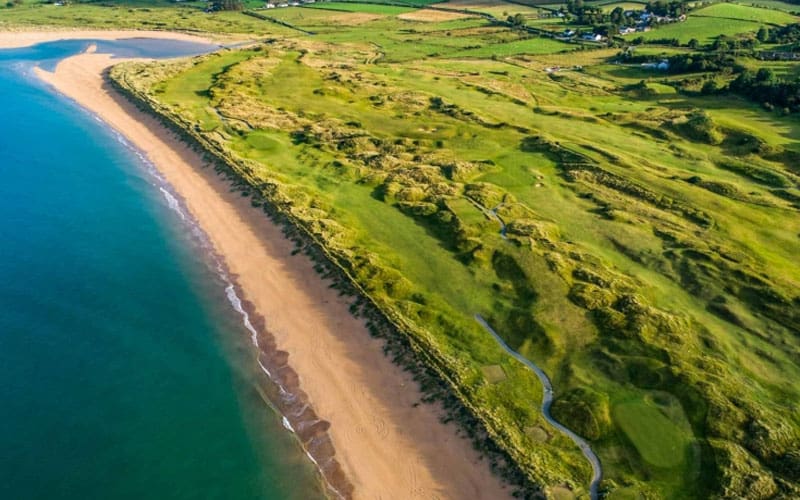
Many people have come to realize that golf in Donegal has become one of the top places to find some great rounds for a great value. The Portsalon golf course runs along the beautiful sandy shores of Ballymastoker Bay, stretching for two miles towards where the mouth of the deep blue Lough Swilly meets the Atlantic Ocean. The beach boasts the EC Blue Flag award for its cleanliness. The Lough is trapped , to the east by the hills of the Inishowen peninsula, and to the west by Knockalla Mountains. We are on the Fanad peninsula, a territory of the ancient MacSwiney clan.
Portsalon was opened for play in 1891 and was established as one of the founding members of the Golfing Union of Ireland. This course was known to have been originally designed by the then titled County Club at Portrush, Charles Thompson.
Portsalon struggled to survive until the members stepped in and bought it in the mid 1980’s. Since then, it has only gotten stronger, in 2002, Pat Ruddy remodeled the course, leaving only 5 original holes. Nine new holes and a few changes to the other holes, this course went from just under 6,000 yards to a challenging 7,000-plus yards.
The views are simply breathtaking here. While visiting Donegal this will definitely be one to visit.
Portmarnock GC
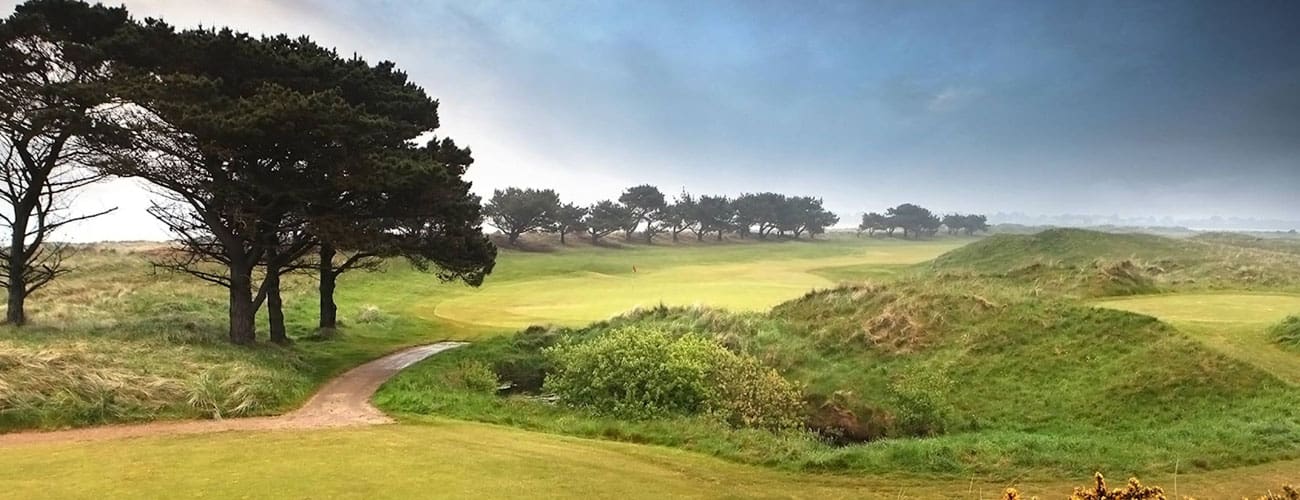
Pormarnock sits just outside Dublin and no trip to the capitol should skip this links. The original 9 holes were laid out here in 1894 by former Open Champion, Mungo park and this is an amazing natural links that occupies the former Jameson Whiskey family estate. In 1896 the course was lengthened to 18 holes and Portmarnock became, as they say, a proper links test.
The course juts out into the sea and is surrounded by water on three sides exposing it to the winds off the Irish Sea. Unlike many of the 19th century links courses that can be short by today’s standards, Portmarnock plays to a sturdy 7,500 yards from the back tees. The links here have hosted the Walker Cup and nearly 20 Irish Opens. This is a championship test of golf.
It’s hard to imagine a more beautiful course and it is maintained to the highest standard. The greens here are recognized as being among the best in the world where the balls run true and at a lightning-fast speed. Great putting here is the key to a strong round. Our favorite hole here, among many wonderful holes, is the par 3 fifteenth. It plays north along the sea at 190 yards with the prevalent east to west wind. The sea lies just to the right so any ball flight that is a fade will likely be steered to the beach. It’s the type of hole that can make or break one’s round.
Portmarnock is a wonderful links experience and we recommend it for every trip to Ireland that includes playing in the Dublin area.
Portmarnock Hotel & Golf Links
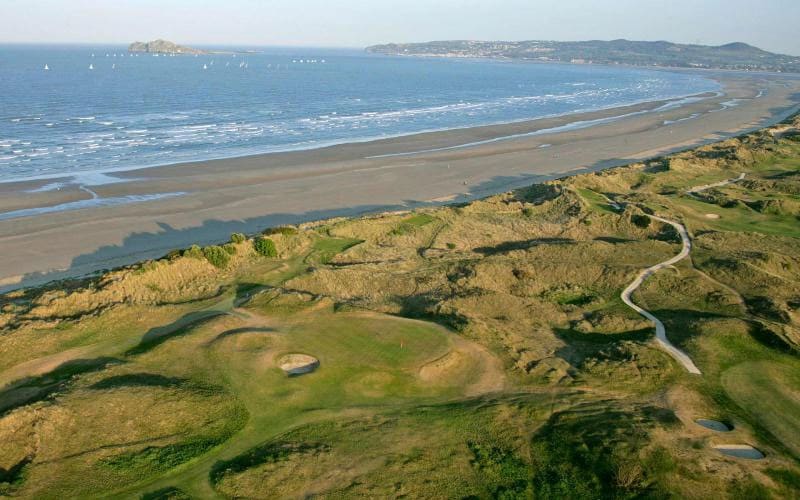
Designed by Bernhard Langer and opened in 1995, Portmarnock Hotel & Golf Links is an understated links. The land is formerly the estate of the famous Jameson Whiskey family and originally, there was a 9-hole layout on the estate. The current layout incorporates the original 9-holes and the first 8 holes play nicely through the natural links terrain. At the ninth hole, the course turns into the craggy, high dunes and feels more like a traditional Irish links.
The course borders the Portmarnock GC and shares the same turf and similar dune scapes. There are several exceptional holes here, notably the short par-4 eighth that plays as a dogleg right with dunes on the left. The choices here are to cut the hole short by driving over the dunes or playing the longer route just short of the large fairy bunker that usually leaves a shot short of under 90 yards. The green is wonderfully sited and sits elevated alongside the dunes.
The par 3 seventeenth is another favorite. This hole plays 193 yards from the back tees and 171 yards from the member tees. The hole plays to the south with a predominant left to right breeze with a large bunker guarding the left side of the green and to the right of the green is a runoff area on tight turf. In other words, there is not a good miss here so take plenty of club and hit the green.
The property has a wonderful hotel with a tremendous whiskey bar. At Portmarnock Hotel & Golf links they like to say, “The only thing overlooked here is the sea!”.
Rosapenna / Sandy Hills
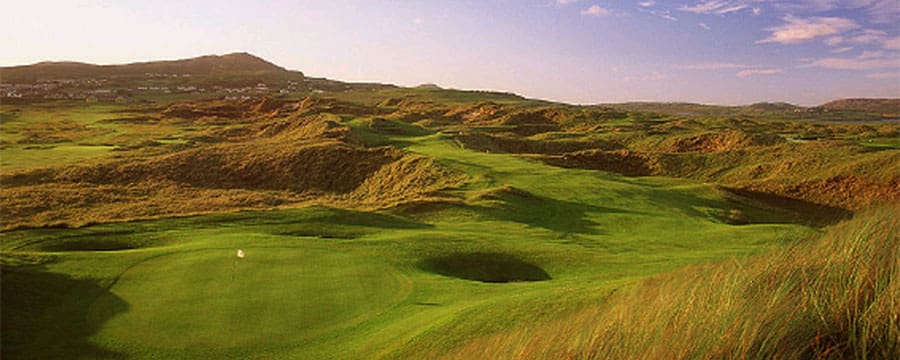
Sandy Hills is one of two links at Rosapenna and it joined their Old Course there in 2003. While it is technically a young links, it feels as though it has been there for hundreds of years. Designed by legendary Irish architect Pat Ruddy, Sandy Hills joined Rosapenna’s Old Course as one of the two full 18-hole layouts. While the Old, designed by Old Tom Morris in 1891, plays alongside the tall dunes at Rosapenna, the Sandy Hills links plays through and over them. This links has stunning views across the Old Course out to Sheephaven Bay. There are many excellent holes here and due to the height of the dunes, golfers feel as though they have the course all to themselves. We’ve played there and never saw another person the entire round. Accuracy off the tee is at a premium here because if you stray offline and into the dunes with their high grass, finding golf balls can be problematic.
Rosapenna is in County Donegal where there are more than a handful of wonderful links including both Rosapenna links, the two courses at Ballyliffin, Donegal, Narin & Portnoo, Portsalon and Cruit Island. A golfer could spend a week without leaving Donegal and enjoy a spectacular links vacation
Rosapenna Sandy Hills links plays to a par of 72 and stretches to nearly 7,200 yards from the tips. Sandy Hills is ranked #1 in the region, #9 in Ireland and #53 in all of the British Isles.
Royal Dublin GC
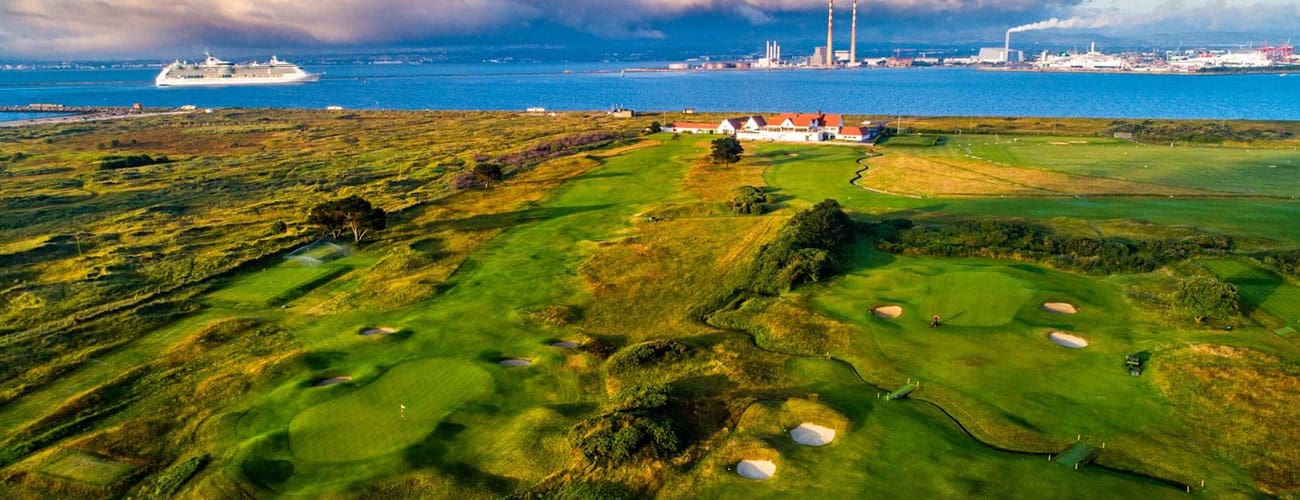
Royal Dublin Golf Club is located on Bull Island, in Dublin Bay. The island was formed following the building of a sea wall in the early 1800’s. The result is a perfect sandy island, suburb terrain for a golf course and an excellent home for flora and fauna. Bull Island is the only UNESCO Biosphere Reserve in a capital city.
The Dublin Golf Club, as it was originally called, was founded in 1885. The club moved twice before the course finally came to rest on Bull Island, in 1889. Two years later Queen Victoria granted the club royal patronage. The course was severely damaged during the First World War and was rebuilt by Harry Colt in 1920.
This is a classic traditional “Scottish” out and back links, relatively unusual for an Irish Links! It is highly rated by the pros, and one pro in particular has fallen in love with Royal Dublinm. Christy O’Conner was the club pro in 1959 and has been firmly attached ever since. The club granted the nine times Irish Open Champion honorary life membership in 1988.
Royal Dublin has seen its fair share of professional tournaments and has hosted numerous Irish Opens, Ballesteros and Langer amongst the winners. But surely Royal Dublin’s favorite champion was Christy O'Connor, who won the Irish Open here in 1966. Today’s championship layout stretches to an impressive 7,269 yards from the tips, so bring your “A” game, especially if the wind is up. Royal Dublin is one of the friendliest “Royal” clubs to be found anywhere. This course is ranked 23rd in Ireland and it is ready to be conquered!
The European Club
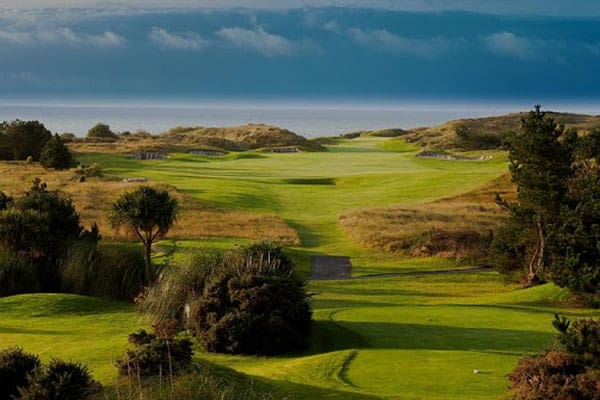
The European Club is located in the garden of Ireland, between the coastal towns of Wicklow and Arklow, about 30 miles south of Dublin. It’s Pat Ruddy’s creation, which opened for play in 1993, and he and his family have stayed there ever since.
This is an inspiring place to play golf, huge dunes provide tremendous definition and the Irish Sea is very much backcloth. It’s a bit of a monster too; the 18-hole layout stretches to more than 7,000 yards, a challenging par 71. Two par 3’s make up the par 77 20-hole layout. They are definitely worth playing and a nice break from tradition.
There is no doubt that Ruddy has a sense of humor - the scorecard is full of witticisms, even the green on the par-four 12th is humorous at over 125 yards long, with any three-putts being an achievement. This is an enjoyable and memorable course. Many of the holes are varied and capture one’s attention and there are some great holes too.
This is a fantastic links course and most likely the last links course to be created in Ireland. You will not regret spending a day out here. This course is ranked #4 in Ireland and 30th in the British Isles! And for good reason!
The Island GC
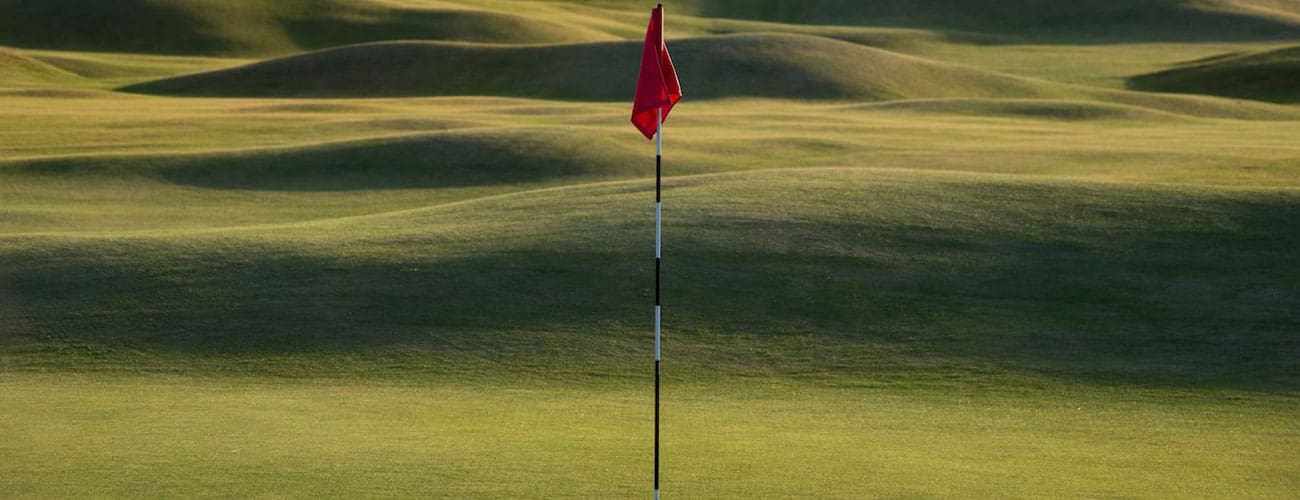
The Island is one of the best-kept secrets in Ireland. While the club has chosen to maintain a low profile since its founding, there is no way to ignore the quality of this links. The Island was founded in 1890 by 10 Irish gentlemen known as “The Syndicate”. At the time, The Island was literally an island that required a short boat ride to the club - now it’s attached by land and access is now open to motorized vehicles. The course is literally surrounded by water and retains its island feel.
The course is wonderfully sited on linksland and still, in 2016, the club hired the firm of Mackenzie & Ebert to create a course master plan to rework the course. Work immediately began on reshaping and improving many of the holes on the linksland and throughout the course, work was done on moving and reshaping the bunkers on half a dozen holes. Later in the renovation process, in 2019-2020, the work shifted to focus on the front 9. While the 3rd hole was renovated, holes 4, 5, 8 & 9 are new. That’s right, four new holes! That shows the level of interest the club has in investing in improving the links to an even higher standard.
One of our favorite holes is the new 4th hole which is a par 3 that plays from an elevated tee with a postage stamp size green shaped like an upside-down saucer guarded by 2 bunkers. Don’t be distracted by the stunning views of the Irish Sea, select the proper club and fire fearlessly at the flag. Another favorite is the par 5 tenth hole which plays long as a dogleg right and is reminiscent of the shape of the 17th at St. Andrews. Strategically placed bunkers dot the edges of the fairway and the green is protected by a large swale right of the green. While cutting the corner may seem like a wise play, the unseen bunkers are in play. Best to play this as a true 3 shot hole.
This fantastic course has hosted many of Ireland’s most prestigious amateur tournaments and is a wonderful addition to any trip to the Dublin area.
Tralee GC
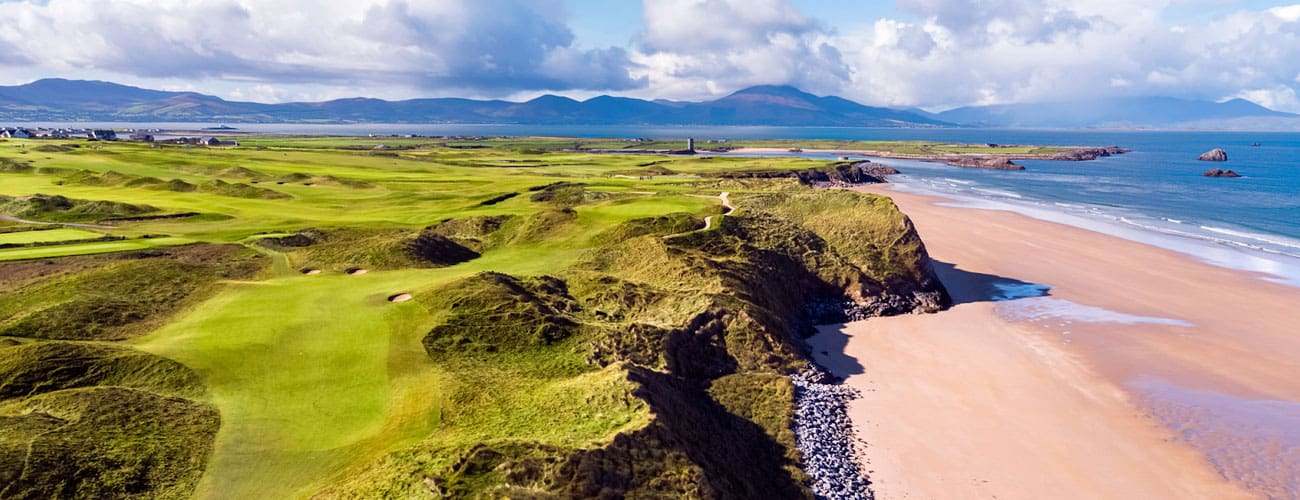
Tralee GC was founded in 1897 but the course, as it plays today, was opened for play in 1984. Designed by Ed Seay and Arnold Palmer, it was Arnie’s first course designed in Europe and arguably his best, as well. The club proudly refers to Tralee as “Arnie’s jewel” and that moniker is spot on.
When Arnold first set foot on the property, he commented, “I have never come across a piece of property so ideally suited for a golf course”. The course is the story of two 9’s. The front side plays outside of the large dramatic dunes that weave through the back side so it feels more ordinary. There are several fine holes on the front and the signature hole is the par-3 third hole.
From the tips, it plays at 200-yards but for us mere mortals hitting from the member tees, it plays to a more modest 156 yards. Take aim at the Norman Castle in ruins to the left of the green, hold your ball on that line and make sure to avoid the right side where the rocky seashore could devour your ball.
It’s been said that the back nine is the finest in Ireland and we wholeheartedly agree. It is spectacular from start to finish. It’s difficult to decide which hole is our favorite here. We love the long par-4 twelfth hole that plays as stroke index 1 and from the member’s tees, it’s 427-yards uphill. The fairway tilts left and can make for an awkward approach. Stay to the right side of the putting surface on your approach as the severe gully on the left is not a good leave. The intimidating 13th, a short par-3 over a cavernous depression requires a tee shot that carries the green because anything short is no good at all. At the penultimate 17th hole, you play a 332-yard par-4 dogleg right along the shore. It’s a beautiful hole to be sure from it’s elevated tee and one that requires a good drive to cover a ravine short of the fairway. Your approach is to a table top green - stay left here because the drop off on the right leads down to the beach. It’s just one more example of the fine holes here.
We really do love Tralee and in the wind, it is a massive test of golf. But fear not because after the round, a very friendly clubhouse awaits with a pint of Guinness with your name on it!
Trump International Doonbeg
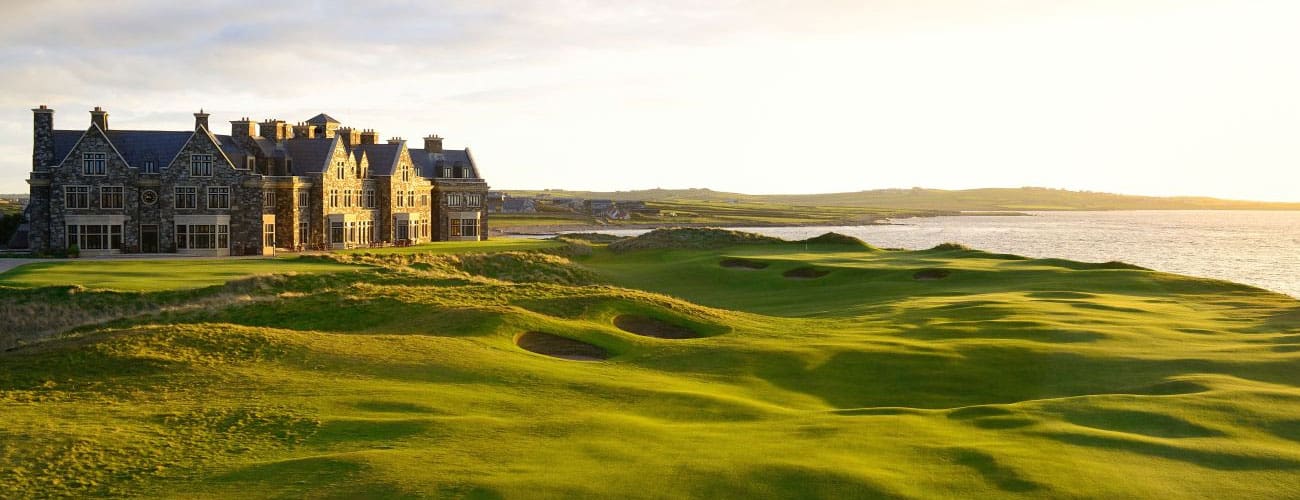
Greg Norman was the original designer of Doonbeg and it was such a perfectly natural piece of linksland that 12 fairways and 14 green sites were simply mown as they were. Very little earth was moved here and the course meanders along a mile and a half of coastline and through sandhills as high as one hundred feet. It’s truly a perfect site for golf. The course opened for play in 2002 to rave reviews but in 2014, the property was acquired by Donald Trump, “refreshed” by Martin Hawtree, and renamed Trump International Doonbeg.
This is a wonderful golf course to be sure. The refreshing done by Hawtree meant softening it a bit for the average golfer, eliminating the bunker in the middle of the 12th green and relocating the par-3 fourteenth. Having played the course in 2007 and 2019, we can say that we prefer the new layout and that the course is immensely playable. The first hole is visually stunning and a perfect opening hole. The fairway is generously wide but the lone fairway bunker down the right is one you want no part of. The green is set up against a towering dune and for the hole’s defense are 7 strategically placed bunkers that demand a precise approach.
Perhaps the signature hole is the short par-3 fourteenth. The one new hole in Hawtree’s refreshing. Playing hard against the Atlantic and just 126 yards in length, this is one of the finest and most aesthetic par-3s in Ireland. This bunker-less hole plays to a turtle back green with steep runoffs and the ocean beckoning on the right. Depending on the wind, one could hit a gap wedge or 4-iron.
The par-4 eighteenth is short at 388-yards but plays to stroke index 6 on the card. There are 2 pot bunkers down the left side of this soft, dogleg right fairway with the Atlantic immediately on the right. The green is canted at an angle that makes approach shots feel awkward especially with three deep bunkers fronting the hole. An approach right means the beach is in play and left of the green are 2 bunkers and a steep runoff. The only play here is to aim for the middle of the green.
This is a wonderful property with an excellent hotel, bar/restaurant and pro shop. Doonbeg should be on your wishlist for any trip to the south of Ireland!
Waterville GC
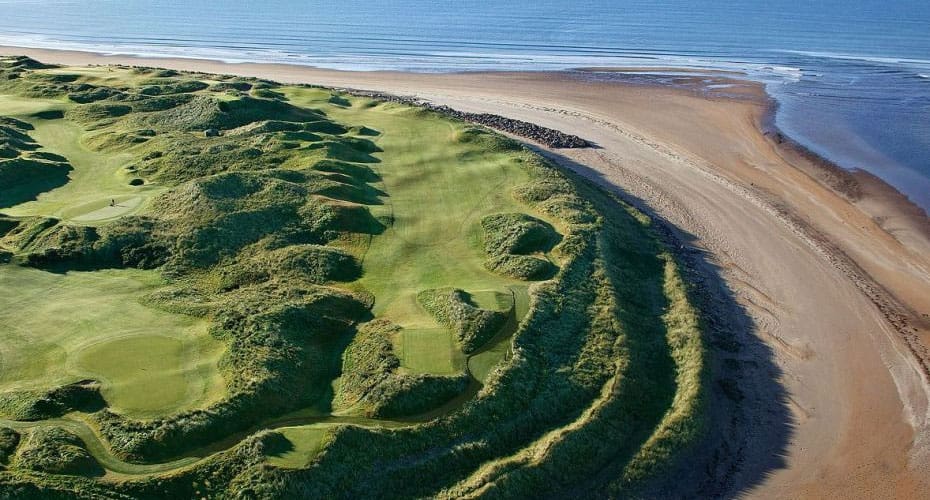
Waterville is a very special place with fantastic links. The club was founded in 1889 and a 9-hole layout was installed. In the ’70s, Master’s champ Claude Harmon and Irish architect Eddie Hackett were commissioned to build a new 18-hole course and the “beautiful monster” was opened for play in 1973. Since then Tom Fazio has been brought in to significantly renovate the course, to provide coastal erosion management, and to construct a first-class practice facility.
Waterville was the spot in the late-90’s where Tiger Woods, John Cook, Mark O’Meara, Jim Furyk and Payne Stewart would stop to prepare for the Open Championship by playing the links here. Sadly, Payne Stewart was to become the club’s honorary captain in 2000 but tragedy struck in 1999 when he died in a plane crash. The club erected a wonderful bronze statue of Payne near the clubhouse that is a favorite photo opportunity for every golf fan.
This course is universally loved and it’s often said there isn’t a weak hole in all 18. The signature hole at Waterville is #17, Mulcahy’s Peak. The tee box here is the highest point on the course and it offers stunning views out to the ocean and of Ireland’s highest mountain range, Macgillycuddy’s Reeks which tops out at 3,400 feet. Seventeen is a par-3 that plays to 194-yards from the back tees and 168-yards from the member’s tees. It’s a beautifully scenic par-3 that plays long in the wind to a green that slopes from back to front with a steep runoff on the left side of the putting surface. The par-5 eighteenth is a wonderfully long finishing hole that stretches to nearly 600-yards into a stiff breeze. Three solid strikes over a very narrow fairway with the ocean beating on the shore on your right and you’re home. What a finish!
The beautiful clubhouse went through a 3-phase renovation that was completed in 2019 and it is now finished to the highest standard. We highly recommend a post-round pint of Guinness from the clubhouse deck to discuss the round and to take in the breathtaking views.
